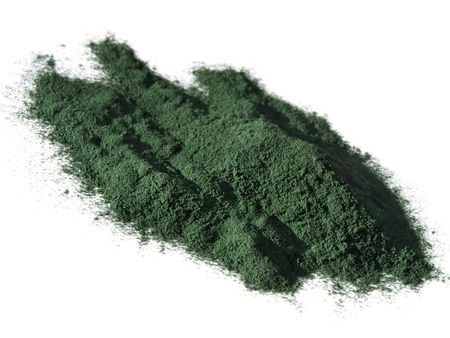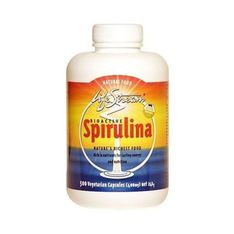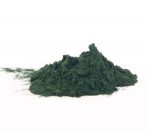
- Spirulina offers a comprehensive nutrient profile – full of vitamins and minerals like vitamin E and zinc, fatty acids and is an attractive blue-green colour.
- The blue-green pigment is phycocyanin which has potent anti-inflammatory properties.
Algae is now an accepted form of single-cell protein (SCP) for human consumption and has been in large-scale production for nearly 50 years. Only a few algal species are suitable for factory growth, none more so than the blue-green algae, Spirulina platensis. It is a spiral shaped algae living in brackish fresh water and has been eaten by many cultures, especially in central Africa. The characteristic protein isolated from this algae is the C-phycocyanin which is a pigmented complex. The protein constitutes 60-75%w/w dry weight.
The algae is a great source of n-3 and n-6 fatty acids, minerals such as zinc and other essential nutrients (Becker, 1994; Tokusoglu and Unal, 2003) such as vitamin E, B12 and beta-carotene. It is a rich source of gamma-linolenic acid (C18:3n-6) (GLA) too which is essential for good skin.
The Key Pigment And Colour – Phycocyanin.
The protein phycocyanin is about 20% w/w dry weight of the total cell protein. It is claimed to have antioxidant and hepatoprotective effects (Minkova et al., 2003). In recent years it has become a valuable source of a natural food colouring especially for blue and green which has been discussed elsewhere (see article Blue Is The Colour). Readers should consult the reference books edited by A. Vonshak on the cultivation of this algae (Vonshak, 1997), and a review by Ciferri (1983).
Spirulina And Its Anti-Inflammatory Benefits.
The pigment C-phycocyanin (C-PC) plays a significant role in regulating inflammatory responses. That role is not lost on those promoting Spirulina as a health food given the high phycocyanin content of the alga. It is only now that scientists are beginning to uncover the significant mechanisms which underpin this anti-inflammatory role. One group using a novel analytical technique based on 35S in vivo/vitro labelling analysis for dynamic proteomic (SiLAD) has uncovered some promising explanations (Hao et al., 2018). One area is the role of phycocyanin’s role in influencing the programmed cell death 5 protein (PDCD5) which mediates anti-inflammatory responses. Macrophages which are part of the inflammatory process were examined using C-PC. Studies show phycocyanin can reduce inflammation through down-regulating PDCD5-NF-κB signaling.
Such evidence is helping to add meat to the novel perspective of an algal functional food involved in an important regulatory mechanism – that of influencing inflammation.

Product Development Opportunities
In product development terms, the blue-green colour is unusual because it is natural and offers the culinologist a novel hue not commonly found. The nutrient profile is particularly rich and should be investigated further because of the sources of vitamin E and zinc. The dietary oil content also has some merit. The algae has been incorporated into smoothies and is often found in combination with chlorella alga and wheatgrass offering a strong nutrient profile.
Products Available

This page contains links to our affiliate marketing partners – Amazon and PaidOnResults. Please read our affiliate disclosure.
References
Becker, E.W. (1994) Microalgae Biotechnology and Microbiology. Cambridge, U.K.: Cambridge Univ. Press. 293 p.
Cifferi, O. (1983) Spirulina, the Edible Microorganism. Microbiol. Rev. Dec. pp. 551-578
Hao, S., Yan, Y., Huang, W., Gai, F., Wang, J., Liu, L., & Wang, C. (2018). C-phycocyanin reduces inflammation by inhibiting NF-κB activity through downregulating PDCD5 in lipopolysaccharide-induced RAW 264.7 macrophages. Journal of Functional Foods, 42, pp. 21-29. https://doi.org/10.1016/j.jff.2018.01.008
Minkova, K.M., Tchernov, A.A., Tchorbadjieva, M.I., Fournadjieva, S.T., Antova, R.E. and Busheva, M.C.H. (2003). Purification of C-phycocyanin from Spirulina (Arthrospira) fusiforms. J. Biotechnology, 102, 55–59.
Tokusoglu, Ö., Ünal M.K. (2003) Biomass Nutrient Profiles Of Three Microalgae: Spirulina platensis, Chlorella vulgaris, and Isochrisis galbana. J. Food Sci., 68(4) pp. 1144-1148
Vonshak, A. Edt. (1997) Spirulina platensis (Arthrospira): Physiology, Cell-biology and Biotechnology. Taylor& Francis. London. UK
1st draft: 28th January 2014. 1st revision: 1st November 2016.

Leave a Reply